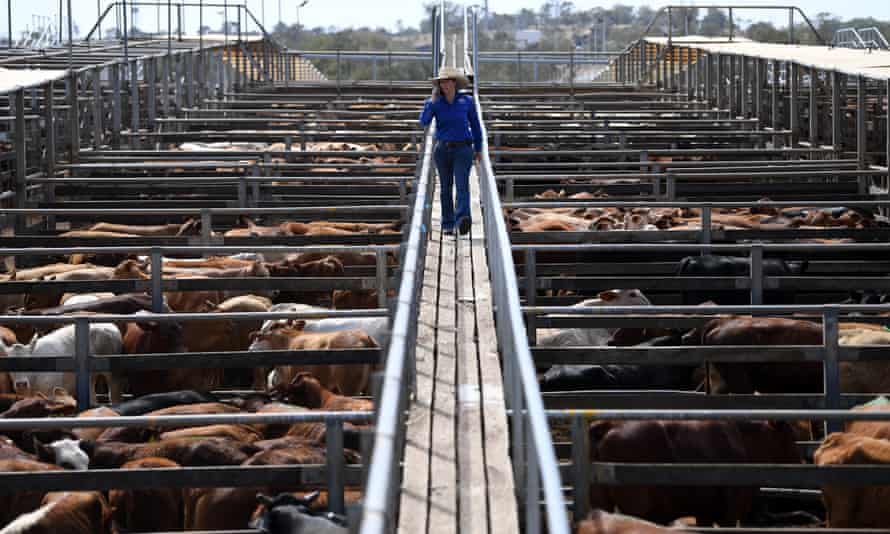Extract from The Guardian
Regions ‘disproportionately affected’ by climate risk but enhancing current emissions reduction programs would help, Ernst & Young analysis shows.
- Lenore Taylor: Our new rural network will expand Guardian Australia’s reach and tell stories that resonate
- Rural Australia has stories to tell that will interest the world. Here’s how we’ll report them
- Australia’s farmers set for record $70bn year – but labour shortages and Covid rules threaten harvest
- Sign up for the rural network email newsletter
- Join the rural network group on Facebook to be part of the community

Cattle saleyards at Roma, part of the Maranoa electorate in Queensland. The Ernst & Young analysis found regional economies like Maranoa are well positioned to seize the upside of carbon farming.
Last modified on Thu 16 Sep 2021 20.48 AEST
Australia’s agricultural sector can reach net zero emissions by 2040, achieving emissions reductions of 40% by 2030 and 60% by 2035 by scaling up existing Morrison government programs, according to new work from Ernst & Young.
The core of the abatement strategy modelled for the group Farmers for Climate Action involves reducing methane, electrifying transport, overhauling some land use, including more reforestation of marginal farmland, and improving land management through practices like increasing carbon sequestered in cropland.
The Ernst & Young analysis also includes a case study of the electorate of Maranoa now held by the federal agriculture minister and Queensland National, David Littleproud. It notes climate-related risks are likely to affect the main industry sectors in Maranoa which include agriculture, mining, electricity, gas and water, and construction.
It says if better management practices were adopted, the transition would drive sustainable prosperity in traditional National party heartland. Maranoa could generate between 58m and 71m Australian carbon credit units over a 10-year period, which would result in an additional $2bn to $2.4bn of revenue that would support 14-17,000 direct jobs in the electorate.
The transition to net zero emissions modelled by Ernst & Young is in comparison to a business-as-usual trajectory that projects what an Australian on-farm emissions profile may consist of from 2020 to 2050.
The prime minister, Scott Morrison, who is attempting to land a climate policy pivot before the Cop26 summit in Glasgow in November, says he wants Australia to reach net zero emissions as soon as possible, and preferably by 2050. But some Nationals have dug their heels in, contending that the transition will cost jobs in regional Australia.
Some Nationals have proposed that agriculture be carved out of Morrison’s climate policy commitments and the deputy prime minister, Barnaby Joyce, declared this week the test for whether or not the Nationals would support the prime minister’s pivot would be the impact of jobs in regional areas, like the coal regions of the Hunter Valley in New South Wales.
While many Nationals have portrayed the transition as a near unachievable revolution that will drive up costs, lock up farmland and necessitate the scaling back of traditional livestock herds – the Ernst & Young work notes that most of the policy tools required to transition Australian agriculture successfully to net zero already exist. They would only require scaling up.
It notes the Morrison government already has “a broad portfolio of initiatives related to climate change” including the carbon farming initiative and an agricultural stewardship package. “With further enhancement, it could be well positioned to assist the sector to decouple economic growth from greenhouse gas emissions and take action to build upon its inherent strengths,” the analysis says.
While the thrust of the report identifies opportunities for farmers to diversify their income streams as they make their operations more resilient in the face of inexorable climate risk, the analysis also points out that expectations and rules are shifting in the export markets that underpin Australia’s regional prosperity.
It says key Asian and European markets increasingly demand transparency through labelling, branding and disclosure for food that is produced “locally, sustainably and ethically”.
The report notes that border adjustments, like the European Union’s Carbon Border Adjustment Mechanism, do not currently extend to agriculture, but it says Australia’s agriculture sector “should be prepared for the risk that agricultural products are captured under the CBAM”.
The new assessment for Farmers for Climate Action comes as medical leaders across the country have penned an open letter to Morrison before Cop26, calling on the government to “urgently take much greater action to avert a further deterioration of the current climate crisis”.
The letter, signed by a dozen peak medical bodies including the Australian Medical Association and Doctors for the Environment, calls on the prime minister to talk “less about aspiration” and instead focus on “firm and binding commitments” that are aligned with the science”.
While not specifying an emissions target, the letter calls on the government to commit to an “ambitious national plan” to cut emissions this decade “to protect health” including policies that accelerate the transition to renewable energy.
It calls for the government to make commitments ahead of Glasgow that are commensurate with limiting global warming to 1.5C.

No comments:
Post a Comment